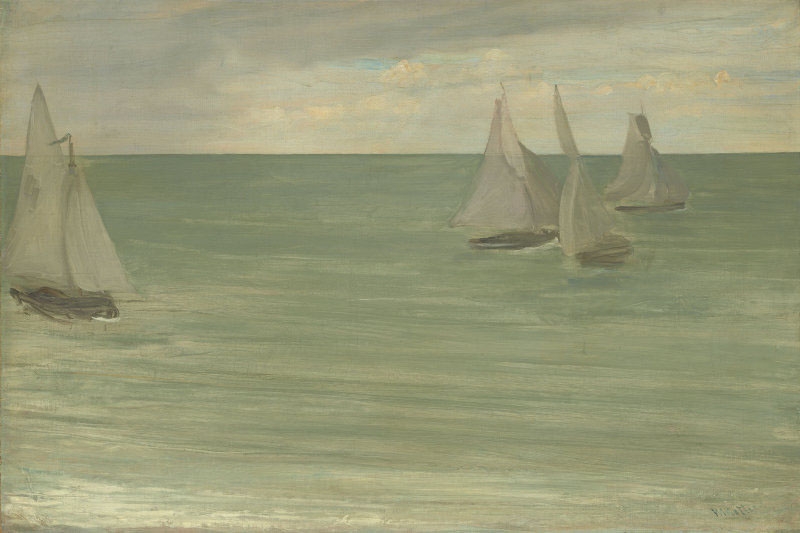Composition
This painting is comparable, to a certain extent, in technique, visual perspective, and composition, to a seascape by Edouard Manet (1832-1883), Sea View, Calm Weather (Art Institute of Chicago), and to a lesser extent to his Les Marsouins, marine (Philadelphia Museum of Art), both of which date from 1864 and were painted in Boulogne. 1
Stephanie L. Strother notes that in such compositions both Manet and Whistler were influenced by Japanese woodcuts, such as two woodcuts by Ando Hiroshige (1797-1858): Shichiri Ferry Crossing, Gate to the Atsuta Shrine, and Nezame Village and Ejiri from the Fifty-Three Stations of the Tokaido (Tokaido gojusan tsugi. 2
Technique
The rather stiff, pasty consistency of the paint, applied smoothly with large brushes over the flat area of the sea with its startling horizon line, and the sharp angles of the boats sculptured across the sea surface, make this a powerful if rather stiff composition.
The medium and technique have been analysed by Kimberley Muir at the Art Institute of Chicago. It was painted on a relatively coarse plain-weave canvas prepared with a thick lead-white based ground, possibly a commercial ground augmented by the artist. The palette includes lead white, red and yellow iron oxide or earth pigments, umber, cobalt blue, Prussian blue, vermilion, and bone black. Muir writes: 'the painting was built up in multiple superimposed wet-in-wet layers. Whistler probably thinned his paints with added medium ... He used brushes, including 1 cm–wide flat brushes ... as well as a knife in places.' 3 Muir gives a very interesting analysis of Whistler's painting technique:
'While the painting has a fairly smooth, flat surface overall, Whistler built up some low texture using brushstrokes of bodied paint ... In the sky, which appears to have been painted first and mainly in a single wet-in-wet session, he used long, horizontal or slightly undulating strokes in varying shades of gray. In places the paint was thinly applied, leaving the brush-marked texture and the warm, off-white tone of the ground visible on the surface. Some of the clouds, by contrast, were formed with thick strokes of cream to pale yellow. Purer colors ... provide streaks of slightly more intense hues where the sun breaks through the otherwise gray sky.'
The horizon was painted freehand, and remains visible through the sails. On the lower third of the canvas, toning layers in light brown and pale purple show through the grey waves. The grey washes include minute fragments of white, blue, and ochre; by contrast, strokes of thicker, lead white-rich paint outline breaking waves. The boats, adds Muir, were painted with 'a few quick wet-in-wet brushstrokes … The more-opaque greenish-gray paint of the distant water was applied last and slightly overlaps the edges of the boats and the sky along the horizon.' 4
Conservation History
The conservation and condition of the painting are also discussed by Kimberley Muir. Overall, the painting is in good condition. The canvas has been lined; the paint is slightly flattened and the canvas weave texture is exaggerated, probably as a result of the lining. There are minor paint losses and some abrasion at the edges, and a variety of cracks, some deep. Muir writes: 'The painting currently appears to have a synthetic varnish. There are residues of old, yellowed, natural-resin varnish in the recesses of the paint texture. The surface has an even, satiny sheen.' 5
Frame
- 1865: unknown, possibly a plain wooden frame.
- 1892/1901: a Grau-style frame was added, probably in the 1890s.
It is not known when the current Grau-style frame was added, and although it is possible that it was when the picture was with the Goupil Gallery in 1891/1892, but it could date from later, possibly when it went to America.
Notes:
1: See Richard Dorment, 'James McNeill Whistler,' in Juliet Wilson-Bareau and David Degener, Manet and the Sea, Philadelphia: Philadelphia Museum of Art, 2004, pp. 187-93.
2: Stephanie L. Strother, 'Cat. 9 Trouville (Grey and Green, the Silver Sea), 1865: Curatorial Entry,' in Whistler Paintings and Drawings at the Art Institute of Chicago, The Art Institute of Chicago, 2020, URL. See also Whitford, Frank, Japanese Prints and Western Painters, New York, 1977; Watanabe 1991 [more] ; Ono 2003 [more] ; and Lambourne 2005 [more] .
3: Muir, Kimberley, 'Cat. 9 Trouville (Grey and Green, the Silver Sea), 1865: Technical Summary,' in Whistler Paintings and Drawings at the Art Institute of Chicago, The Art Institute of Chicago, 2020, URL.
5: Muir 2020, op. cit.
Last updated: 14th December 2020 by Margaret







